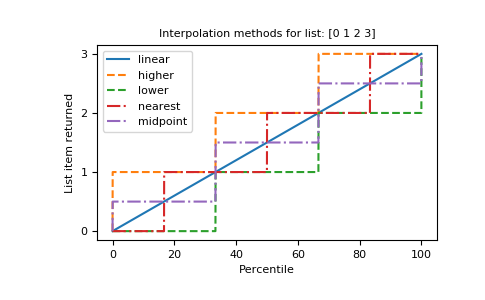numpy.percentile¶
-
numpy.percentile(a, q, axis=None, out=None, overwrite_input=False, interpolation='linear', keepdims=False)[source]¶ Compute the qth percentile of the data along the specified axis.
Returns the qth percentile(s) of the array elements.
Parameters: - a : array_like
Input array or object that can be converted to an array.
- q : array_like of float
Percentile or sequence of percentiles to compute, which must be between 0 and 100 inclusive.
- axis : {int, tuple of int, None}, optional
Axis or axes along which the percentiles are computed. The default is to compute the percentile(s) along a flattened version of the array.
Changed in version 1.9.0: A tuple of axes is supported
- out : ndarray, optional
Alternative output array in which to place the result. It must have the same shape and buffer length as the expected output, but the type (of the output) will be cast if necessary.
- overwrite_input : bool, optional
If True, then allow the input array a to be modified by intermediate calculations, to save memory. In this case, the contents of the input a after this function completes is undefined.
- interpolation : {‘linear’, ‘lower’, ‘higher’, ‘midpoint’, ‘nearest’}
This optional parameter specifies the interpolation method to use when the desired percentile lies between two data points
i < j:- ‘linear’:
i + (j - i) * fraction, wherefractionis the fractional part of the index surrounded byiandj. - ‘lower’:
i. - ‘higher’:
j. - ‘nearest’:
iorj, whichever is nearest. - ‘midpoint’:
(i + j) / 2.
New in version 1.9.0.
- ‘linear’:
- keepdims : bool, optional
If this is set to True, the axes which are reduced are left in the result as dimensions with size one. With this option, the result will broadcast correctly against the original array a.
New in version 1.9.0.
Returns: - percentile : scalar or ndarray
If q is a single percentile and axis=None, then the result is a scalar. If multiple percentiles are given, first axis of the result corresponds to the percentiles. The other axes are the axes that remain after the reduction of a. If the input contains integers or floats smaller than
float64, the output data-type isfloat64. Otherwise, the output data-type is the same as that of the input. If out is specified, that array is returned instead.
See also
median- equivalent to
percentile(..., 50)
quantile- equivalent to percentile, except with q in the range [0, 1].
Notes
Given a vector
Vof lengthN, theq-th percentile ofVis the valueq/100of the way from the minimum to the maximum in a sorted copy ofV. The values and distances of the two nearest neighbors as well as the interpolation parameter will determine the percentile if the normalized ranking does not match the location ofqexactly. This function is the same as the median ifq=50, the same as the minimum ifq=0and the same as the maximum ifq=100.Examples
>>> a = np.array([[10, 7, 4], [3, 2, 1]]) >>> a array([[10, 7, 4], [ 3, 2, 1]]) >>> np.percentile(a, 50) 3.5 >>> np.percentile(a, 50, axis=0) array([[ 6.5, 4.5, 2.5]]) >>> np.percentile(a, 50, axis=1) array([ 7., 2.]) >>> np.percentile(a, 50, axis=1, keepdims=True) array([[ 7.], [ 2.]])
>>> m = np.percentile(a, 50, axis=0) >>> out = np.zeros_like(m) >>> np.percentile(a, 50, axis=0, out=out) array([[ 6.5, 4.5, 2.5]]) >>> m array([[ 6.5, 4.5, 2.5]])
>>> b = a.copy() >>> np.percentile(b, 50, axis=1, overwrite_input=True) array([ 7., 2.]) >>> assert not np.all(a == b)
The different types of interpolation can be visualized graphically:
import matplotlib.pyplot as plt a = np.arange(4) p = np.linspace(0, 100, 6001) ax = plt.gca() lines = [ ('linear', None), ('higher', '--'), ('lower', '--'), ('nearest', '-.'), ('midpoint', '-.'), ] for interpolation, style in lines: ax.plot( p, np.percentile(a, p, interpolation=interpolation), label=interpolation, linestyle=style) ax.set( title='Interpolation methods for list: ' + str(a), xlabel='Percentile', ylabel='List item returned', yticks=a) ax.legend() plt.show()
